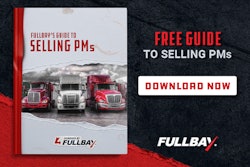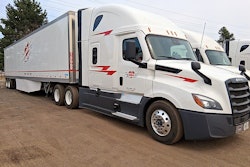Diesel prices have risen fairly steadily since bottoming out in January when crude oil was trading at about $50 a barrel.
Diesel prices have risen fairly steadily since bottoming out in January when crude oil was trading at about $50 a barrel. As of late April, the national average is $2.877, and prices are just a hair below the $3 threshold in many parts of the country.
In this issue, we look across disciplines at some of the ways trucking operations can save on fuel costs – through price risk management, alternative fuels, information analysis and equipment selection. We don’t pretend to cover everything; certainly fuel cards, ptimization software and savvy maintenance practices, among others, are key to saving money on diesel. Rather, we are highlighting just a few important tools – some of which you might not have considered.
HEDGING YOUR BETS ON FUEL
Fleets of all sizes have pricing options
Hedging is a term that likely intimidates many fleet owners who think it’s an option only for owners of large fleets who employ at least a few MBA graduates. True, various forms of fuel hedging require someone to understand the inner workings of commodities markets and global petroleum demand, but that person doesn’t have to be the trucking executive. And clearly, size matters when it comes to negotiating directly with fuel suppliers. But while some hedging mechanisms might require a fleet to be a large purchaser of fuel, fleets of all sizes can leverage the market power of a larger group – or of the commodities markets.
The simplest form of price risk management – not really hedging – involves collective purchasing, such as through a group fuel program or a buying cooperative. For example, members of the National Association of Small Trucking Companies (www.nastc.com) can participate in the NASTC Quality Plus Network, which offers cost-plus discounts at more than 700 fuel stops. The discounts are applied daily and are reflected in the initial billing on each tank. Or there are rebate programs such as TruckersB2B (www.truckersb2b.com).
Hedging is more sophisticated in that it typically involves limiting the overall price in some way – not just discounts on a potentially volatile fuel price. In some cases, that means limiting the price of fuel directly. Sometimes, it means investing in one or more financial instruments that effectively “reimburse” fleet owners as costs rise. But that protection comes at some kind of premium, so fleet owners must assess the upfront costs versus the likely benefits.
Hedging as insurance
Among the factors involved in deciding whether and how to hedge are the degree of market volatility and the likelihood of upward pressure on prices. The current diesel climate fits the bill in both cases, according to Brad Simons, president of Simon Petroleum’s Pathway Network (www.simonspetroleum.com).
“The outlook is higher prices in future months,” says Simons. “Demand for crude oil remains strong globally.” That’s not to say there won’t be volatility, he says. There could be volatility due to demand swings in nations like China, where it’s difficult to get advance word on economic booms and slumps. “In March, China’s crude oil imports were 9 percent higher than a year ago,” Simons says. Since the beginning of winter, crude has swung between a low of $50 a barrel to about $65, translating into a retail diesel price swing of 45 to 60 cents, he says.
Due to an expectation for higher prices through the rest of the year, Simons Petroleum is recommending a cap-style program that protects fuel buyers against fuel price spikes. “The only thing that would change the upward trend is a global slowdown,” Simons says. “We felt it best to secure a program that would limit upside.”
A traditional fixed-price program simply would lock in prices, but fleet owners would not have an opportunity to enjoy the benefits when prices fell below the set price. Had a fleet locked in at $2.60 in late September 2006, for example, it would be in great shape today, but based on the Energy Information Administration national average, it would have missed out on lower prices in all but three weeks until March of this year.
“There are two types of people – ones who think the market is going to go up and ones who think the market is going to go down,” Simons says. That helps explain why caps haven’t been more popular. “Trucking companies are eternal optimists. A lot of these guys don’t want to pay a premium [if diesel prices are going to fall].”
But Simons argues that fleet owners should think of hedging not as speculating on the direction of fuel prices but as buying an insurance policy. The fuel buyer pays a premium to ensure that fuel prices don’t exceed a certain level. It’s risk management just like liability insurance. Fleet owners don’t think of insurance as a bad deal just because they don’t have an accident, and they shouldn’t dismiss hedging just because prices don’t exceed a certain level, he notes. Plus, with a cap program, the fuel buyer still gets to participate in the savings if prices fall.
Caps have long been the right move in an uptrending market, but they have been so expensive that they were cost-prohibitive for many buyers, Simons says. The company recently introduced a lower-premium cap that has attracted more interest, he says. The cap applies when the fuel buyer uses one of the stops in the Pathway Network.
Surcharges as hedging
Optimism and stinginess aren’t the only forces dampening the interest in hedging. A fleet’s ability to recover fuel surcharges from its customers softens the blow of rising fuel prices and makes many trucking company executives unwilling to pay a premium to restrain diesel prices.
Simons acknowledges this point, but he notes that even if every shipper pays the surcharge – and that assumption is perhaps less sound as freight volume weakens – the carrier still is exposed for fuel that can’t be billed to the surcharge, such as idle time, out-of-route miles and deadheading. A carrier might choose to protect only the fuel burned for these activities and rely on surcharges for the rest, Simons says. “One other piece to consider is that intra-week fuel price volatility will impact a carrier negatively. The EIA Average benchmark only resets weekly, and fuel is purchased daily.”
The fact remains that fuel surcharges are an important element in many carriers’ fuel management programs. Trucking companies may not always appreciate just how lucky they are.
“Nobody else has anything like that,” says Jim Burr, vice president of FCStone Trading (www.fcstone.com), which hedges many different commodities in energy, agriculture and other sectors. “Everyone else does their own hedging. Trucking companies make their customers do theirs.”
In an era of tight capacity, trucking companies have successfully substituted surcharges for hedging. So in effect, it’s shippers, not carriers, who today need fuel hedging most, Burr says. FCStone pioneered a new approach under which the shipper buys protection against higher surcharges in the same way a carrier would buy a cap on fuel prices. For a few cents paid on every mile, a shipper could ensure that it is reimbursed for any surcharges over a predetermined level. FCStone and the National Industrial Transportation League have co-sponsored several seminars on the topic of fuel surcharge risk management and have more planned.
Although most of the interest to date has been from the shipper community, Burr says some of FCStone’s carrier clients are using the concept to offer surcharge-free freight. Rather than FCStone working with the shipper directly to provide surcharge reimbursement based on a fixed per-mile payment, the carrier works with FCStone to offer a shipper contract terms without a fuel surcharge in the first place – provided the shipper agrees to the same fixed per-mile payment. Since the surcharge is often the big unknown expense in a freight contract, this structure often allows the shipper to know its maximum payment to the carrier.
“If I were a carrier, I would be all over it to take business from someone else,” Burr says. Some major trucking companies, including a Top 10 carrier, are trying this approach, he adds. And since from the carrier’s perspective, the fuel surcharge program would operate much like a cap to reimburse fuel costs, the carrier would need to hedge only the fuel not covered by a surcharge, Burr says.
Whether the hedging is done by the carrier or by the shipper, it’s crucial they understand that they are buying protection, Burr says. “The biggest single mistake these companies make is to say that was a waste. What they should say is ‘I hope this is a waste.’ ”
–Avery Vise
Can biodiesel curb oil dependence?
Fleets report varied experience with popular alternative
In the wake of Hurricane Katrina and diesel prices above $3 a gallon, many fleet owners began thinking about alternatives – especially biodiesel, an agriculturally based fuel that usually is blended with standard petroleum diesel. As many discovered quickly, even where you can find biodiesel, there often was little or no price benefit. Plus, there were concerns over quality. On the other hand, a few fleets are taking a longer view and are hoping that by working through the quality issues, proving the benefits and driving more buying, the trucking industry can reduce its dependence on foreign oil.
Last year, A.D. Transport Express experimented with blending virgin soy into the low-sulfur diesel fuel in its terminal tanks. Management felt that biodiesel fuel was “the right thing to do” environmentally, and – just as important – it made sense financially, says David Konopka, director of quality for the Canton, Mich.-based fleet.
The company was saving between 5 and 10 cents per gallon by purchasing the less expensive pure virgin soy – called B99 – and blending it with low-sulfur diesel at 20 percent (B20) admixture. Konopka felt there may have been a slight drop in fuel economy from the company’s use of its homemade B20 biodiesel. Drivers said they noticed a boost in performance when A.D. Transport Express stopped blending soy and went back to 100 percent low-sulfur diesel.
A.D. Transport was forced to put the program on hold after purchasing a contaminated load of biodiesel during the fall of 2006. “What we thought was pure virgin soy turned out to be used vegetable oil, and it shut down 12 of our trucks,” Konopka says. The supplier paid A.D. Transport for the damages involved in the incident, but the supplier will see no more of A.D. Transport’s business.
“Standards are needed to regulate the quality of biodiesel fuel coming out of suppliers, just as there are for conventional fuels,” Konopka says. “Biodiesel is still a relatively new market. Until such standards are in place, fuel buyers need to be very careful.” After the incident and a supplier change, Konopka insisted on receiving a certification of authenticity on every load from the manufacturer.
Economically speaking, using biodiesel makes sense when conventional diesel fuel prices are high. Today, virgin soy is $2.64 a gallon – $2.10 plus 54 cents tax – whereas conventional diesel is hovering around $2.69 a gallon. Companies can reduce their cost further by applying for a blender’s credit that will reduce the amount of tax they pay on their biodiesel purchases.
“All in all, it was not a bad experience,” Konopka says. “During the warmer months, we were able to help our economy, our environment and our fuel cost using the B20 blend.”
Proving biodiesel’s worth
Dale Decker wants to show that some of the challenges biodiesel users like A.D. Transport have faced are not insurmountable. Almost a quarter of the way into a two-million-mile test of biodiesel, Fort Dodge, Iowa-based Decker Truck Line reported positive results in March during a news conference at the Mid-America Trucking Show in Louisville, Ky.
In conjunction with several partners, Decker Truck Line launched the biodiesel demonstration project last fall with tight controls over the quality of the fuel and meticulous attention to proper methodology for comparing standard diesel and biodiesel (See Innovators, December 2006).
“What we’ve observed so far is great performance in the particularly cold winter we just experienced, and reduced maintenance and engine wear benefits,” said Decker, industry and government relations director for the trucking company.
Hard numbers are not yet available from the identically spec’d trucks – one set of control tractors and one variable, so that comparisons can be made from the test – which began rolling last fall and 350,000 miles ago with a B20 blend of biodiesel.
“We did nothing to the engines at all, just filled them up,” said Decker. Increased lubricity, and the fact that biodiesel burns cleaner, are seen as the source of decreased maintenance, he said. Although no engines have been pulled apart yet, anecdotal evidence suggests that biodiesel is effective.
While mileage fell off a little, it was within driver variables, Decker said, adding that he expects the loss to disappear once some adjustments are made in driver rotation. Decker Truck Line, which hauls to all lower 48 states and Canada with 700 tractors and more than 1,400 trailers, is using mostly flatbeds, with some vans and reefers, in the test, running from Iowa to either Chicago or Minneapolis.
Decker Truck Line and Iowa Central Community College have developed a website (www.2millionmilehaul.com) to show results from the ongoing study that will end in fall 2008. The interim test results were announced by the partners in the Two Million Mile Haul, which includes Decker, Caterpillar, the National Biodiesel Board, the U.S. Department of Agriculture, Iowa Central Community College and Renewable Energy Group.
–Aaron Huff and John Latta
CLARIFYING FUEL ECONOMY
Savvy analysts leverage technology to spot the causes of waste and improve mpg.
In the past two years, Barry McGrady has analyzed volumes of fuel economy data for Floyd & Beasley Transfer Co. The cause of poor performance is usually a “smoking gun,” says McGrady – vice president of IT and human resources for the 200-truck carrier based in Sycamore, Ala. – but sometimes his analysis uncovers less obvious causes.
Recently, McGrady noticed a sudden drop in fuel economy for one vehicle, and he assumed it correlated with a new driver assignment. But the data showed that a change in drivers happened one month before the incident. As McGrady dug deeper into the data, he spotted the most likely cause – a change of tires.
“It happened at the exact time the fuel economy started dropping,” McGrady says. “I turned the data over to the shop for their action.”
For many fleets, 2006 marked a frightening trend, as volatile fuel costs surpassed labor as the top expense. With no price relief in sight, managers are looking more closely at their data to gain more insight and control over the variables in their operations that drive fuel economy. With the right technology, fleet managers like McGrady can quickly identify the cause, intervene and monitor the results for improvement – all without leaving their desks.
Finding the root cause
McGrady uses an Excel spreadsheet weekly to calculate the fleet mpg average and rank all vehicles and drivers from worst to best.
“That’s the first test,” McGrady says. “I would prefer to try to deal with people below average. Within that pool, I look at the ones that are the worst first.”
McGrady’s spreadsheet draws from two sources. The mpg for each vehicle comes from the electronic control module via Qualcomm’s SensorTracs performance reporting solution. McGrady pulls the current driver-vehicle assignment file from the company’s McLeod LoadMaster enterprise management system to link each vehicle’s mpg to a driver.
Before contacting the bottom performers, McGrady reviews their detailed data in the SensorTracs database to isolate the root cause. “Most of the time, it is what you expect,” says McGrady, who pays special attention to idle time, over-revs – indicative of poor shifting habits – and speed. He has identified idle time and over-revs as the two most common causes of poor fuel economy, but occasionally he finds drivers below the fleet average for mpg because their average speed is higher than the fleet’s average speed.
Technology from onboard computing and mobile communications providers offers immediate access to vehicle and driver fuel performance. To pin down the root causes of poor fuel performance, experienced fuel analysts pay close attention to the variation in fuel economy from one period to the next.
“Looking at fuel on a day-to-day basis is great,” says Brett Vitrano, operations research analyst with Accelerated Freight Group. “It gives you a good assessment, but you are looking at a very minute aspect of the picture.”
AFG – a 70-truck carrier based in Theodore, Ala. – uses ADV Monitor, a performance reporting feature of GeoLogic’s multimode communications and tracking system. Every Monday morning, Vitrano downloads data into a spreadsheet to analyze the three variables he believes are the most critical measures: fuel consumption, idle time (as a percentage) and mpg.
“By looking at it weekly and monthly, it allows me to see whether we are trending in a bad way or a good way,” Vitrano says. “If we see three days where consumption has increased, that is not a good assessment of what our consumption is. If it is trending up for three weeks, that gives me a better understanding for what is truly going on.”
Idle percentage is a good example of why trends – as opposed to snapshots – are revealing, Vitrano says. Idle times rise significantly during the summer and winter months due to in-cab cooling and heating. By analyzing the range of movement for idle times throughout the year, Vitrano can set goals for idle times – along with other metrics – for specific periods of the year, and by driver.
AFG’s analysis shows that idle percentage should remain below 30 percent on average, and mpg should be above 6.0. “We are using logic and math to get an understanding of what is acceptable and what is not in the circumstances that surround it, and communicating that to drivers,” Vitrano says.
Digging deeper
Because an average gives all variables equal weight, that might not be the best way to view fuel economy for fleets operating in multiple locations and using mixed equipment.
In February 2005, Andersen Logistics implemented an onboard computing and mobile communications system from PeopleNet for one of its regional private fleets. The 16-truck fleet based in Brooklyn Park, Minn., is one of several operated by Andersen Logistics, a division of window and door manufacturer Andersen Windows.
Using PerformX – a real-time driver and vehicle performance evaluation tool from PeopleNet – Anderson Logistics management decided to narrow its focus on three critical variables for fuel economy: over-revs, overspeed and long idle time. When fleet manager John Mathias looked at the initial data, he saw the fleet average for mpg was 6.4. While acceptable by most standards, the data varied widely by vehicle and driver. “Guys were all over the map,” Mathias says.
But the average did not take into account the fleet’s equipment mix, among other factors. Andersen Logistics operates both straight trucks and tractors. To find a more meaningful basis to evaluate fleet performance, Mathias spoke with truck manufacturers to find the optimal thresholds for fuel economy in terms of RPM and speed for each type of power unit.
For optimal fuel economy, manufacturers said the optimal threshold for RPM was 2,100 for straight trucks and 1,600 for tractors. The optimal speed for fuel economy was 55 mph, but since 55 mph was not a realistic threshold for drivers on 70 mph highways, the company decided to set PerformX to gather statistics on speeds over 65 mph. For idle time, it chose five minutes as the threshold to begin counting stats on long idle time.
“Once you have the optimal, figure out the threshold for your fleet,” says Mathias, who adds that performance also should be evaluated by location. “We can’t compare ours with the Chicago branch. We operate differently.”
Another way to establish performance thresholds is to evaluate the performance of each driver and vehicle using a statistical formula called regression analysis, says AFG’s Vitrano. Regression analysis finds the curve or line that best fits a given set of data points; the equation for this curve or line can be used to project future results.
Large corporations often use regression analysis to predict future earnings from historical data. At AFG, Vitrano uses an application from SPSS Software to run a regression analysis to determine what idle time, fuel consumption and mpg should be throughout the year for each driver, and for the fleet, based on past performance.
“You can do (regression analysis) for the fleet as a whole, but it is more accurate to see how the driver will perform in the future,” Vitrano says. “We can also say to a driver, ‘We didn’t incorporate results from other drivers into our finding.’ ”
Through regression analysis, the fleet has determined that idle times generally should stay under 30 percent, given most weather conditions.
“Given certain situations, if we see that a driver repeatedly abuses idle time or his fuel card, then we can call him in and lay out our cards, and say ‘Mathematically, this is what should be going on. We need to have a talk and find common ground,’ ” Vitrano says.
Regression analysis is most accurate when used to evaluate drivers that travel over the same route and terrain, but it’s useful even if that’s not the case, Vitrano says. “There is always going to be a margin of error, but the more information I can put my hands on, the more I can perfect things to as close as they can come.”
Analyzing fuel economy data taken directly from the vehicle’s ECM is the most precise method for determining the amount of fuel consumed over a given distance. When computing mpg, however, the ECM does not have the intelligence to account for fuel that is consumed because of inefficient routing.
“We have two separate ways of measuring fuel economy,” says Jim Gervais, director of maintenance at O&S Trucking. Using its dispatch software, the Springfield, Mo.-based truckload carrier keeps a record of fuel purchases through an interface with its fuel purchase card vendor. It divides the gallons by the dispatch miles – using shortest or practical miles, for example – to get the “overall” mpg for each driver
and for the fleet.
O&S Trucking, which operates 350 tractors, then cross-references the mpg as reported by its dispatch system versus the ECM; the difference takes into account out-of-route miles. “If a driver takes 50 miles home and back, the 100 miles is not paid miles,” Gervais says. “That is actual fuel we purchased for the truck. That is a good reflection of what it costs to operate the truck.
“When we look just at ECM data, we are getting 6.3, 6.4 and above,” Gervais says. “This is a broad range, and there are a lot of variables involved in that. We shoot for 6 mpg for overall fuel economy. You’ve got to get all the other things factored in.” (For more on how to address out-of-route mileage, see “Fuel analytics in real time,” on this page.)
Advanced tools
Although fleets are using simple analysis tools like Excel to perform powerful analysis of fuel costs, software developers offer more sophisticated analytical tools that do much of the work for the user. For advanced cost analysis of fuel and other business areas, McLeod Software offers a data warehousing system called Profitability Analysis. The system enables users to select from 90 tables of data to customize reports and views.
“We have actual fuel transactions tied into these tables,” says David Custred, McLeod Software’s director of sales services. For example, a manager could find the average fuel cost and miles for a lane over a certain data range; he then could dig deeper by matching up actual fuel costs to a shipper or consignee in that lane, or to a particular driver or tractor. The manager also could bring in what was billed for each lane, the fuel surcharges collected and the actual miles that drivers ran for each lane.
Advanced costing systems that integrate with transportation management systems also can be used to pinpoint the true cost of each shipment, including fuel. Fleets can determine what shipments are fully compensated with the fuel surcharge and those that are not, says Ken Manning, president of Transportation Costing Group.
For both less-than-truckload and truckload carriers, the fuel surcharge does not cover costs incurred by inefficient routing of shipments, i.e. out-of-route miles. A truckload carrier that adds a fuel surcharge of 45 cents per mile will not be paid a surcharge for empty miles or out-of-route miles; shippers are going to pay a fuel surcharge on the shortest or practical miles, Manning says.
For LTL carriers, the fuel surcharge can be especially complex because it is typically based on a percentage of revenue, such as 2.8 percent. Does this surcharge adequately reflect the shipment’s true cost? Not likely, Manning says. “That compensation varies widely by size of shipment and distance because the consumption of fuel by any of those individual shipments or loads is variable,” Manning says. “The fuel surcharge isn’t.”
Intervention strategies
By analyzing the variables that impact fuel economy and their costs to the bottom line, fleets can fine-tune their intervention strategies and technology to improve performance.
Once Andersen Logistics determined what metrics to monitor, management began meeting regularly with drivers to emphasize the importance of keeping within the thresholds for RPMs, overspeed and long idle time; it also used these meetings to provide constant feedback to drivers on their performance. In January 2005, the fleet reached a peak average of 8.7 mpg, as well as an overall average of 7.7 in 2005.
“We are taking a chunk out of a big spend,” Mathias says. Based on the average fuel price, the company estimates fuel savings in excess of $18,000 in less than one year.
A more enforceable intervention strategy is to configure vehicle settings to mandate certain behaviors. O&S Trucking decided to install auxiliary power units on all of its company equipment to reduce idling, and to minimize the variability of its fuel economy during the summer and winter.
For trucks equipped with APUs, the company set its engines to shut off automatically after four minutes of idling. But this initial policy had a problem that surfaced during the extreme cold temperatures in the Midwest.
“APUs were not able to keep the cab warm enough,” Gervais says. “You run into a lot of problems when temperatures go below the 10- to 20-degree mark.” To address this issue, the company now is running a test to configure the ECMs to monitor the ambient outside temperature; if the temperature outside falls below a certain point, the ECM will allow the truck to idle.
O&S Trucking also has used the fuel economy incentive programs from its engine manufacturers. At first, the company set the ECMs to automatically adjust the tractor’s top speed according to the drivers’ fuel economy, but with various types of equipment, management found it difficult to come up with one set of standards.
“The fuel economy program in the ECM is pretty hard to manage,” Gervais says. “We were struggling to keep drivers happy with that.” The company now has set its trucks with a top speed limit, but – because fuel economy actually dropped – the carrier is evaluating whether it set the speed too high.
Overall, O&S Trucking has seen improvements over the last couple of years because of driver training, APU installation and closer monitoring of fuel economy. “It is not the steady increase we were hoping for, but we attributed this to the speed setting,” Gervais says.
Considering the savings from even incremental improvements in fuel economy, the time spent identifying and correcting the causes of poor performance is time well spent.
Fuel analytics in real time
Routing visibility helps fleets adjust on the fly
Advances in information technology are blurring the line between analytics – traditionally an after-the-fact dissection of reality – and operational decision making. Out-of-route mileage is a case in point. Through interactive fuel interfaces, fleet managers can see a fuel transaction as soon as a driver leaves the pump, says David Custred, director of sales services at McLeod Software. Managers can see those transactions as they happen, including the latitude and longitude of the stop, to make sure the driver is in the correct route and to recalculate the ETA for the driver’s next stop.
Instead of waiting for the end of a predetermined timeframe to produce fuel reports, a real-time alerting product called The Dawg by TMW allows fleets to take advantage of information – as identified in TMW’s Results Now business intelligence tool and its Management Reporting systems – as it happens.
“For example, we have a customer that is currently using our products to compare real-time GPS information with operational system trip data to determine if the driver is out of route,” says Keith Mader, vice president of TMWSuite development. “Once an out-of-route condition is identified, our Dawg product will alert the appropriate person via e-mail that an exception has occurred.”
Also, a WorkCycle product from TMW will create a user-defined task list that shows up in a user’s work queue, which identifies steps needed to take care of the out-of-route condition. “In this case, the end user must call the driver, record a reason for the out of route, and inform the customer if the load will be late,” Mader says.
‘WAIST’ NOT, WANT NOT
Learn how to tighten your belt on fuel economy
If you’ve been through a powertrain-spec’ing exercise, you’ve probably chosen engines with enough horsepower for your application without overkill (see “Savvy spec’ing 1: Understanding engine power needs,” CCJ, March 2002). You’ve probably also chosen the best transmission/rear axle combinations for your engines, loads, speeds and terrain.
But according to Recommended Practices from the Technology & Maintenance Council, there are other areas where spec’ing the right equipment and calibrations can contribute substantially to vehicle fuel efficiency. The three highest-payback areas are aerodynamics, idle limiting and road-speed limiting.
Resist the resistance
By most industry estimates, overcoming air resistance can consume about the same amount of available power as rolling resistance – up to about 40 percent, depending on the shape of the truck.
So if you’re neatly carving through the air with a clean wedge-shaped vehicle – instead of bullying your way through with something resembling a barn door – your power, and fuel, will be spent on making miles, not wind.
According to TMC, a standard roof-mounted wind deflector can provide up to a 6 percent improvement in fuel economy. A full-roof fairing (sides closed above the roof) can contribute up to a whopping 15 percent, with cab extenders contributing another 1 to 2 percent. And a front air dam and tractor side skirts each can contribute up to 3 percent.
The latter two devices serve to shield the high drag of axles, oil pans and other aerodynamically “dirty” under-cab components, says TMC. Side skirts also help get airflow attached to the sides of the tractor near the ground. Without them, near-ground airflow is very turbulent










